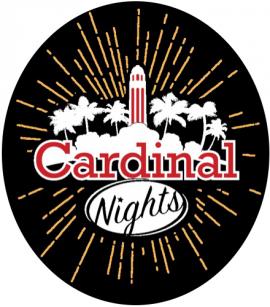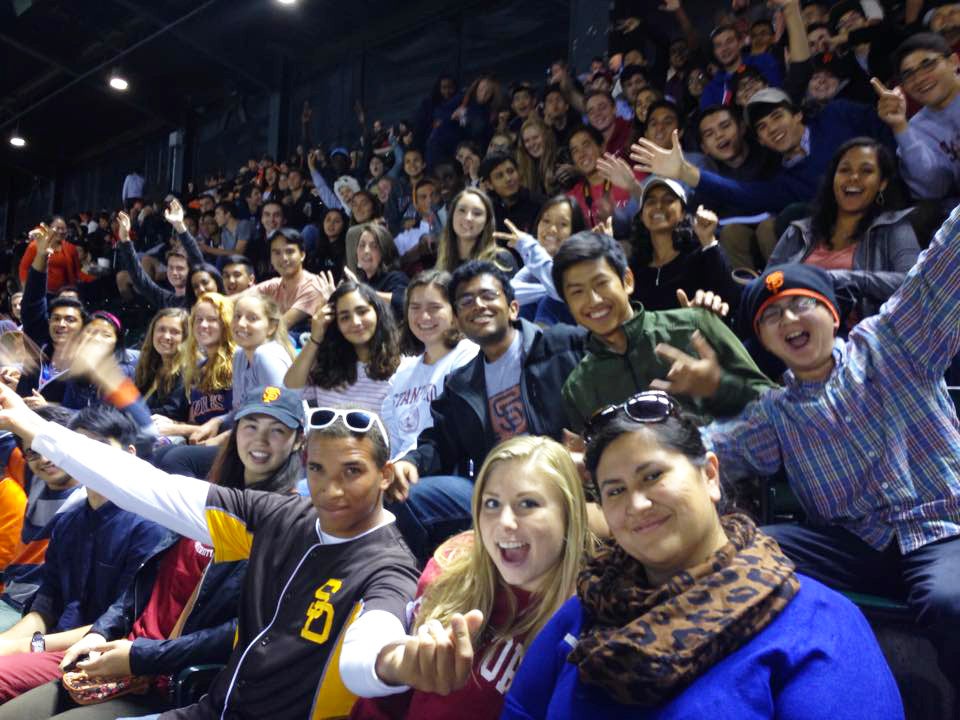Having fun at Stanford without alcohol
Since many Stanford students don’t have cars, getting to a movie theater can be challenging – except on movie nights offered by Cardinal Nights, which provides discounted tickets and free transportation to students looking for a fun night out with friends new and old.
This quarter, in addition to movie outings, the popular Cardinal Nights program has offered free tickets to a concert in Dinkelspiel Auditorium by Jesse McCartney, as well as a meet-and-greet event before the show with the ’90s pop idol, and discounted tickets and a free shuttle ride to a San Francisco Giants game at AT&T Park.
Cardinal Nights, which offers students safe, sober, comfortable – and fun – ways to spend weekend nights, is a program of the Office of Alcohol Policy and Education (OAPE), which also offers financial assistance to students who can’t afford the price of a discounted ticket.
“As a whole, Cardinal Nights has found its niche on campus and become popular by planning events that college students love, but don’t always have the time or energy to plan out themselves,” said Delaynie Koenig, OAPE’s substance-free community engagement adviser. “Having something to do three nights a week, guaranteed, is appealing to students and we do our best to pick hot-ticket items like Broadway shows and Great America trips that will engage a wide variety of students.”
Cardinal Nights, whose attendance surged 25 percent to 24,046 last year, is one of several Stanford programs designed to enhance student health and safety by empowering them to make good choices around alcohol consumption.
In addition to sponsoring Cardinal Nights, Stanford distributed more than $70,000 to student groups and residence halls to enhance alcohol-free events.
“We take a comprehensive approach to shifting the campus culture away from alcohol and to reducing high-risk drinking, because college substance abuse is a complex problem that requires a multifaceted solution,” said Ralph Castro, OAPE’s director.
 Last year, the OAPE expanded its services and its outreach and education programs following a generous financial contribution by a donor. The expansion coincided with the implementation of a new Stanford University Student Alcohol Policy that prohibited large containers of hard alcohol at undergraduate parties.
Last year, the OAPE expanded its services and its outreach and education programs following a generous financial contribution by a donor. The expansion coincided with the implementation of a new Stanford University Student Alcohol Policy that prohibited large containers of hard alcohol at undergraduate parties.
Promising trends, ongoing challenges
To measure the effectiveness of its programs, the OAPE surveys a representative sample of first-year, sophomore, junior and senior students at the end of winter quarter about their behavior, attitudes toward drinking and knowledge of Stanford’s student alcohol policies.
According to the OAPE figures, Cardinal Nights attracted students who don’t drink, as well as an increasing percentage of students who self-identify as drinkers, but are looking for alcohol-free entertainment.
“Last year, 40 percent of students that drink alcohol who attended Cardinal Nights events said they were likely or very likely to have been drinking had they not attended the event,” Castro said. “That means we pulled four in 10 Stanford students who would be consuming alcohol out of the drinking culture on those evenings.”
According to the report, 30 percent of undergraduates identified wine as their drink of choice last year, compared with 21 percent in 2015-16.
“In the scheme of things, choosing wine over, say, hard alcohol helps, because wine has less alcohol by volume than hard liquor,” Castro said.
In 2016, Stanford transported 39 students by ambulance to the hospital for alcohol poisoning, compared with the five-year running annual average of 58.6 transports. However, early in this academic year, there are indications that emergency transports are trending higher, particularly among first-year students.
In fall 2016, 63 percent of first-year students reported drinking before going out (“pre-gaming”) and 64 percent reported consuming shots of hard alcohol. In fall 2015, the percentages of both high-risk behaviors were higher: 78 percent reported pre-gaming and 79 percent reported consuming shots. However, in fall 2017, a rising percentage of first-year students reported engaging in both behaviors compared with their counterparts in 2016.
“Every year, with first-year students, we have a new cohort that needs to be educated on the dangers of binge drinking in a college environment,” Castro said. “We need to be vigilant and consistent in our approach and messaging. It will take time to fully assess changes in the drinking culture and some fluctuations are to be expected from year to year.”
The 2016-17 statistics revealed some promising trends and ongoing challenges:
- Shots of hard alcohol as the drink of choice among first-year students has declined by 30 percent since 2015.
- Citations for alcohol possession declined to 29 citations in 2016-17, compared with the historical annual average of 44 citations.
- Among all undergraduates, frequent use of hard liquor shots – four or more times within the past month – declined by 5 percent last year.
- Sixty percent of undergraduates agreed that consuming shots of hard liquor puts them at greater risk of blackouts, hangovers and alcohol poisoning.
- About 50 percent of students reported adhering to the new alcohol policy.
Enhancing existing programs
Currently, OAPE is training 28 peer health educators – upper-class students managed by Wellness and Health Promotion Services at Vaden – who will present OAPE’s alcohol education curriculum in residence halls across campus during winter quarter.
“We’re training the peer health educators on facilitation techniques and the curriculum itself, and smoothing out any issues that came up since we launched the pilot alcohol education program last year,” said Natalie Thomas, manager of education and outreach at OAPE. “Public health literature has shown that peer education is effective in correcting misperceptions of drinking norms and preventing alcohol and substance abuse.”
This quarter, OAPE is also offering training for students who will serve as “sober monitors” for campus organizations that plan to host larger or numerous parties. Under the university’s Party Planning Guide, students must recruit sober monitors to help them control their parties – watch the serving area, check IDs at the door, monitor the dance floor, and call for help if an intoxicated guest needs assistance.
Castro said Stanford carefully monitors student parties.
“Every week, we review the registered student parties that are happening that weekend with individuals from Stanford’s Department of Public Safety, the Fire Marshal’s Office, and housing and residential education,” he said. “We distribute that list of parties to a large group of constituents across campus, so we all know where parties are happening. We’ve been doing that for years. It’s probably one of the most comprehensive student party oversight programs in the nation.”
Castro said Stanford is a leader in student alcohol education programs.
“We are always pushing forward, looking for the next innovative thing we can do, the next issue we can tackle to help students make better choices around drinking,” Castro said.
“We will never be satisfied that we have done enough, because if even one student is going to the emergency room for alcohol poisoning, or one student is feeling marginalized in their residential community because of drinking, that is one student too many.”

